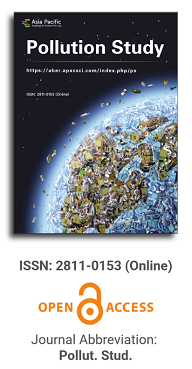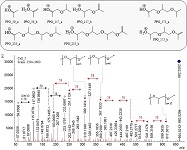
Asia Pacific Academy of Science Pte. Ltd. (APACSCI) specializes in international journal publishing. APACSCI adopts the open access publishing model and provides an important communication bridge for academic groups whose interest fields include engineering, technology, medicine, computer, mathematics, agriculture and forestry, and environment.

The (partial) replacement of synthetic polymers with bioplastics is due to increased production of conventional packaging plastics causing for severe environmental pollution with plastics waste. The bioplastics, however, represent complex mixtures of known and unknown (bio)polymers, fillers, plasticizers, stabilizers, flame retardant, pigments, antioxidants, hydrophobic polymers such as poly(lactic acid), polyethylene, polyesters, glycol, or poly(butylene succinate), and little is known of their chemical safety for both the environment and the human health. Polymerization reactions of bioplastics can produce no intentionally added chemicals to the bulk material, which could be toxic, as well. When polymers are used to food packing, then the latter chemicals could also migrate from the polymer to food. This fact compromises the safety for consumers, as well. The scarce data on chemical safety of bioplastics makes a gap in knowledge of their toxicity to humans and environment. Thus, development of exact analytical protocols for determining chemicals of bioplastics in environmental and food samples as well as packing polymers can only provide warrant for reliable conclusive evidence of their safety for both the human health and the environment. The task is compulsory according to legislation Directives valid to environmental protection, food control, and assessment of the risk to human health. The quantitative and structural determination of analytes is primary research task of analysis of polymers. The methods of mass spectrometry are fruitfully used for these purposes. Methodological development of exact analytical mass spectrometric tools for reliable structural analysis of bioplastics only guarantees their safety, efficacy, and quality to both humans and environment. This study, first, highlights innovative stochastic dynamics equations processing exactly mass spectrometric measurands and, thus, producing exact analyte quantification and 3D molecular and electronic structural analyses. There are determined synthetic polymers such as poly(ethylenglycol), poly(propylene glycol), and polyisoprene as well as biopolymers in bags for foodstuffs made from renewable cellulose and starch, and containing, in total within the 20,416–17,495 chemicals per sample of the composite biopolymers. Advantages of complementary employment in mass spectrometric methods and Fourier transform infrared spectroscopy is highlighted. The study utilizes ultra-high resolution electrospray ionization mass spectrometric and Fourier transform infrared spectroscopic data on biodegradable plastics bags for foodstuffs; high accuracy quantum chemical static methods, molecular dynamics; and chemometrics. There is achieved method performance |r| = 0.99981 determining poly(propylene glycol) in bag for foodstuff containing 20,416 species and using stochastic dynamics mass spectrometric formulas. The results highlight their great capability and applicability to the analytical science as well as relevance to both the fundamental research and to the industry.
Methane emissions and air quality: A growing concern
Vol 6, Issue 2, 2025
Download PDF
Abstract
Methane, a potent greenhouse gas, has gained prominence due to its significant contribution to global climate change. Beyond its climate impact, this review recognizes methane’s dual role in influencing local and regional air quality, underscoring its growing concern in the context of contemporary environmental issues. The paper aims to provide an overview of methane sources, geographic distribution, long-term health effects, interactions with other pollutants, and the pivotal role of integrated monitoring systems in effective pollution control strategies. The review delves into the primary sources of methane emissions, including anthropogenic and natural processes. Geographically, it identifies high-risk areas, with substantial emissions concentrated in North America, Europe, and Asia. Prolonged exposure to elevated methane levels in urban and industrial settings is associated with respiratory, cardiovascular, and neurological health issues. Furthermore, methane’s interaction with other pollutants leads to the formation of secondary organic aerosols and ground-level ozone, exacerbating air quality challenges. Efficient pollution control hinges on integrating satellite and ground-based data into monitoring systems, ensuring accurate and timely information. Managing methane emissions presents a complex dilemma, impacting both local air quality and global climate. Addressing this dual challenge necessitates a comprehensive approach encompassing legislative reforms, technological advancements, increased public awareness, and international collaboration. A swift response is imperative to mitigate the adverse effects of methane emissions on the environment and human health.
Keywords
References
- Jackson RB, Down A, Phillips NG, et al. Natural Gas Pipeline Leaks Across Washington, DC. Environmental Science & Technology. 2014; 48(3): 2051–2058. doi: 10.1021/es404474x
- Methane Tracker. Methane and climate change—Analysis—IEA. Available online: https://www.iea.org/reports/methane-tracker-2021/methane-and-climate-change (assessed on 12 July 2024).
- United Nations Environment Programme and Climate and Clean Air Coalition. Global Methane Assessment: Benefits and Costs of Mitigating Methane Emissions. Nairobi: United Nations Environment Programme. 2021.
- Saunois M, Stavert AR, Poulter B, et al. The Global Methane Budget 2000–2017. Earth System Science Data. 2020; 12(3): 1561–1623. doi: 10.5194/essd-12-1561-2020
- IEA. Methane Tracker 2021. Available online: https://www.iea.org/reports/methane-tracker-2021 (assessed on 12 July 2024).
- Ocko IB, Naik V, Paynter D. Rapid and reliable assessment of methane impacts on climate. Atmospheric Chemistry and Physics. 2018; 18(21): 15555–15568. doi: 10.5194/acp-18-15555-2018
- Rao S, Klimont Z, Smith SJ, et al. Future air pollution in the Shared Socio-economic Pathways. Global Environmental Change. 2017; 42: 346–358. doi: 10.1016/j.gloenvcha.2016.05.012
- Angaye TC, Ohimain EI, Wankasi D. Spatial and temporal level of methane gas from some dumpsites in Yenagoa metropolis. MOJ Toxicol. 2019; 5(2): 69‒71.
- Staniaszek Z, Griffiths PT, Folberth GA, et al. The role of future anthropogenic methane emissions in air quality and climate. npj Climate and Atmospheric Science. 2022; 5(1): 21. doi: 10.1038/s41612-022-00247-5
- Mar KA, Unger C, Walderdorff L, Butler T. Beyond CO2 equivalence: The impacts of methane on climate, ecosystems, and health. Environmental Science & Policy. 2022; 134: 127–136. doi: 10.1016/j.envsci.2022.03.027
- Nisbet EG, Manning MR, Dlugokencky EJ, et al. Very Strong Atmospheric Methane Growth in the 4 Years 2014–2017: Implications for the Paris Agreement. Global Biogeochemical Cycles. 2019; 33(3): 318–342. doi: 10.1029/2018gb006009
- Hanif S, Lateef M, Hussain K, et al. Controlling air pollution by lowering methane emissions, conserving natural resources, and slowing urbanization in a panel of selected Asian economies. PLOS ONE. 2022; 17(8): e0271387. doi: 10.1371/journal.pone.0271387
- Allen DT. Methane emissions from natural gas production and use: Reconciling bottom-up and top-down measurements. Current Opinion in Chemical Engineering. 2014; 5: 78–83. doi: 10.1016/j.coche.2014.05.004
- Johnson D, Clark N, Heltzel R, et al. Methane emissions from oil and gas production sites and their storage tanks in West Virginia. Atmospheric Environment: X. 2022; 16: 100193. doi: 10.1016/j.aeaoa.2022.100193
- Riddick SN, Mauzerall DL, Celia MA, et al. Measuring methane emissions from abandoned and active oil and gas wells in West Virginia. Science of The Total Environment. 2019; 651: 1849–1856. doi: 10.1016/j.scitotenv.2018.10.082
- Alvarez RA, Zavala-Araiza D, Lyon DR, et al. Assessment of methane emissions from the U.S. oil and gas supply chain. Science. 2018; 361(6398): 186–188. doi: 10.1126/science.aar7204
- USEPA. Global Methane Initiative. Importance of methane. Available online: https://www.epa.gov/gmi/importance-methane (assessed on 23 August 2024).
- Li S, Wang C, Gao P, et al. High-Spatial-Resolution Methane Emissions Calculation Using TROPOMI Data by a Divergence Method. Atmosphere. 2023; 14(2): 388. doi: 10.3390/atmos14020388
- UNEP. Methane emissions are driving climate change. Here’s how to reduce them—UNEP: Facts about Methane | UNEP—UN Environment Programme. Available online: https://www.unep.org/news-and-stories/story/methane-emissions-are-driving-climate-change-heres-how-reduce-them (accessed on 25 August 2024).
- Sampedro J, Waldhoff S, Sarofim M, Van Dingenen R. Marginal Damage of Methane Emissions: Ozone Impacts on Agriculture. Environmental and Resource Economics. 2023; 84(4): 1095–1126. doi: 10.1007/s10640-022-00750-6
- Schiermeier Q. Global methane levels soar to record high. Nature. 2020.
- Ofori CG, Osei CS. Environmental and health impacts of methane emissions. Africa Centre for Energy Policy. 2024.
- Saunois M, Jackson RB, Bousquet P, et al. The growing role of methane in anthropogenic climate change. Environmental Research Letters. 2016; 11(12): 120207. doi: 10.1088/1748-9326/11/12/120207
- Tollefson J. Scientists raise alarm over ‘dangerously fast’ growth in atmospheric methane. Nature. 2022.
- Climate Watch (2024) – with major processing by Our World in Data. “Methane emissions from agriculture” [dataset]. Climate Watch, “Greenhouse gas emissions by sector” [original data]. Retrieved March 18, 2025 from https://ourworldindata.org/grapher/methane-emissions-agriculture
- Howarth RW, Santoro R, Ingraffea A. Venting and leaking of methane from shale gas development: Response to Cathles et al. Climatic Change. 2012; 113(2): 537–549. doi: 10.1007/s10584-012-0401-0
- Shindell D, Kuylenstierna JCI, Vignati E, et al. Simultaneously Mitigating Near-Term Climate Change and Improving Human Health and Food Security. Science. 2012; 335(6065): 183–189. doi: 10.1126/science.1210026
- Nowak DJ, Hirabayashi S, Bodine A, Greenfield EJ. Tree and forest effects on air quality and human health in the United States. Environmental Pollution. 2014; 193: 119–129. doi: 10.1016/j.envpol.2014.05.028
- Escobedo FJ, Kroeger T, Wagner JE. Urban forests and pollution mitigation: Analyzing ecosystem services and disservices. Environmental Pollution. 2011; 159(8–9): 2078–2087. doi: 10.1016/j.envpol.2011.01.010
- Myhre G, Shindell D, Bréon FM, et al. Anthropogenic and Natural Radiative Forcing. In: Stocker TF, Qin D, Plattner GK, et al. (editors). Climate Change 2013: The Physical Science Basis. Cambridge University Press; 2014.
- Shindell D, Borgford-Parnell N, Brauer M, et al. A climate policy pathway for near- and long-term benefits. Science. 2017; 356(6337): 493–494. doi: 10.1126/science.aak9521
- World Health Organization. Air pollution and health. Available online: https://www.who.int/news-room/fact-sheets/detail/ambient-(outdoor)-air-quality-and-health (accessed on 1 February 2025).
- IPCC. In: Climate Change 2013: The Physical Science Basis. Cambridge University Press; 2014.
- UNEP/WMO. Integrated Assessment of Black Carbon and Tropospheric Ozone: Summary for Decision Makers. United Nations Environment Programme and World Meteorological Organization. 2011.
- Dessens O, Köhler MO, Rogers HL, et al. Aviation and climate change: The impact of NOx emissions on atmospheric composition and radiative forcing. Atmospheric Environment. 2014; 95: 142–148.
- Zhuang BL, Li S, Wang TJ, et al. Interaction between the black carbon aerosol warming effect and East Asian monsoon using RegCM4. Journal of Geophysical Research: Atmospheres. 2019; 124(2): 1014–1031.
- Flanner MG, Zender CS, Randerson JT, Rasch PJ. Present-day climate forcing and response from black carbon in snow. Journal of Geophysical Research: Atmospheres. 2007; 112(D11). doi: 10.1029/2006jd008003
- Ma J, Zhang T, Guan X, et al. The Dominant Role of Snow/Ice Albedo Feedback Strengthened by Black Carbon in the Enhanced Warming over the Himalayas. Journal of Climate. 2019; 32(18): 5883–5899. doi: 10.1175/jcli-d-18-0720.1
- Jacobson MZ. Strong radiative heating due to the mixing state of black carbon in atmospheric aerosols. Nature. 2001; 409(6821): 695–697. doi: 10.1038/35055518
- Kopacz M, Mauzerall DL, Wang J, et al. Origin and radiative forcing of black carbon transported to the Himalayas and Tibetan Plateau. Atmospheric Chemistry and Physics. 2011; 11(6): 2837–2852. doi: 10.5194/acp-11-2837-2011
- Shindell D, Ravishankara AR, Kuylenstierna JCI, et al. Global Methane Assessment: Benefits and Costs of Mitigating Methane Emissions. United Nations Environment Programme. 2021.
- Smith P, Bustamante M. Agriculture, Forestry and Other Land Use (AFOLU). In: Climate Change 2014: Mitigation of Climate Change. Cambridge University Press; 2014.
- Bogner J, Abdelrafie Ahmed M, Diaz C, et al. Chapter 10. Waste Management. In: Metz, B., Davidson, O.R., Bosch, P.R., Dave, R. and Meyer, L.A., Eds., Climate Change 2007: Mitigation. Contribution of Working Group III to the Fourth Assessment Report of the Intergovernmental Panel on Climate Change, Cambridge University Press, Cambridge; 2007.
- Sarofim MC, Waldhoff ST, Anenberg SC. Valuing the Ozone-Related Health Benefits of Methane Emission Controls. Environmental and Resource Economics. 2017; 66(1): 45–63. doi: 10.1007/s10640-015-9937-6
- Avnery S, Mauzerall DL, Fiore AM. Increasing global agricultural production by reducing ozone damages via methane emission controls and ozone‐resistant cultivar selection. Global Change Biology. 2013; 19(4): 1285–1299. doi: 10.1111/gcb.12118
- Shindell D, Faluvegi G, Kasibhatla P, Van Dingenen R. Spatial Patterns of Crop Yield Change by Emitted Pollutant. Earth’s Future. 2019; 7(2): 101–112. doi: 10.1029/2018ef001030
- Shindell DT. Crop yield changes induced by emissions of individual climate‐altering pollutants. Earth’s Future. 2016; 4(8): 373–380. doi: 10.1002/2016ef000377
- Schneising O, Burrows JP, Dickerson RR, et al. Remote sensing of fugitive methane emissions from oil and gas production in North American tight geologic formations. Earth’s Future. 2014; 2(10): 548–558. doi: 10.1002/2014ef000265
- Turner AJ, Frankenberg C, Wennberg PO, Jacob DJ. Ambiguity in the causes for decadal trends in atmospheric methane and hydroxyl. Proceedings of the National Academy of Sciences. 2017; 114(21): 5367–5372. doi: 10.1073/pnas.1616020114
- Varon DJ, Jacob DJ, McKeever J, et al. Quantifying methane point sources from fine-scale (GHGSat) satellite observations of atmospheric methane plumes. Atmospheric Measurement Techniques. 2018. doi: 10.5194/amt-2018-171
- Lan X, Thoning KW, Dlugokencky EJ. Trends in globally-averaged CH4, N2O, and SF6. Available online: https://doi.org/10.15138/P8XG-AA10 (accessed on 1 February 2025).
- Dlugokencky EJ, Steele LP, Lang PM, Masarie KA. The growth rate and distribution of atmospheric methane. Journal of Geophysical Research: Atmospheres. 1994; 99(D8): 17021–17043. doi: 10.1029/94jd01245
- Masarie KA, Tans PP. Extension and integration of atmospheric carbon dioxide data into a globally consistent measurement record. Journal of Geophysical Research: Atmospheres. 1995; 100(D6): 11593–11610. doi: 10.1029/95jd00859
- da Silva NF, Schoeler GP, Lourenço VA, et al. First order models to estimate methane generation in landfill: A case study in south Brazil. Journal of Environmental Chemical Engineering. 2020; 8(4): 104053. doi: 10.1016/j.jece.2020.104053
- Lu YY, Zhang HD, Zhou Z, et al. Current Status and Effective Suggestions for Efficient Exploitation of Coalbed Methane in China: A Review. Energy & Fuels. 2021; 35(11): 9102–9123. doi: 10.1021/acs.energyfuels.1c00460
- Metya A, Datye A, Chakraborty S, et al. Methane sources from waste and natural gas sectors detected in Pune, India, by concentration and isotopic analysis. Science of The Total Environment. 2022; 842: 156721. doi: 10.1016/j.scitotenv.2022.156721
- Peng S, Giron C, Liu G, et al. High resolution assessment of coal mining methane emissions by satellite in Shanxi, China. EarthArXiv. 2022. doi: 10.31223/x5493w
- Francis D, Weston M, Fonseca R, et al. Trends and variability in methane concentrations over the Southeastern Arabian Peninsula. Frontiers in Environmental Science. 2023; 11. doi: 10.3389/fenvs.2023.1177877
- de Gouw JA, Veefkind JP, Roosenbrand E, et al. Daily Satellite Observations of Methane from Oil and Gas Production Regions in the United States. Scientific Reports. 2020; 10(1): 1379. doi: 10.1038/s41598-020-57678-4
- Niemeyer RJ, Cantrell SC, Anderson CM. Assessing methane hazards in occupational settings. Journal of Occupational and Environmental Hygiene. 2020; 17(8): 377–390.
- Kovalev AA, Elistratov SA, Popov VA. Assessment of methane emission hazards in underground mining. Journal of Mining Science. 2019; 55(3): 451–460.
- West JJ, Fiore AM, Horowitz LW, Mauzerall DL. Global health benefits of mitigating ozone pollution with methane emission controls. Proceedings of the National Academy of Sciences. 2006; 103(11): 3988–3993. doi: 10.1073/pnas.0600201103
- Ebi KL, Vanos J, Baldwin JW, et al. Extreme Weather and Climate Change: Population Health and Health System Implications. Annual Review of Public Health. 2021; 42(1): 293–315. doi: 10.1146/annurev-publhealth-012420-105026
- Brandt AR, Heath GA, Kort EA, et al. Methane Leaks from North American Natural Gas Systems. Science. 2014; 343(6172): 733–735. doi: 10.1126/science.1247045
- Jacob DJ, Turner AJ, Maasakkers JD, et al. Satellite observations of atmospheric methane and their value for quantifying methane emissions. Atmospheric Chemistry and Physics. 2016; 16(22): 14371–14396.
- Shindell DT, Faluvegi G, Koch DM, et al. Improved Attribution of Climate Forcing to Emissions. Science. 2009; 326(5953): 716–718. doi: 10.1126/science.1174760
- West JJ, Fiore AM, Horowitz LW, Mauzerall DL. Global health benefits of mitigating ozone pollution with methane emission controls. Proceedings of the National Academy of Sciences. 2006; 103(11): 3988–3993. doi: 10.1073/pnas.0600201103
- Pandey S, van Nistelrooij M, Maasakkers JD, et al. Daily detection and quantification of methane leaks using Sentinel-3: A tiered satellite observation approach with Sentinel-2 and Sentinel-5p. Remote Sensing of Environment. 2023; 296: 113716. doi: 10.1016/j.rse.2023.113716
- Ge M, Korrensalo A, Laiho R, et al. Plant-mediated CH4 exchange in wetlands: A review of mechanisms and measurement methods with implications for modelling. Science of The Total Environment. 2024; 914: 169662. doi: 10.1016/j.scitotenv.2023.169662
- Anenberg SC, Bindl M, Brauer M, et al. Using Satellites to Track Indicators of Global Air Pollution and Climate Change Impacts: Lessons Learned From a NASA‐Supported Science‐Stakeholder Collaborative. GeoHealth. 2020; 4(7). doi: 10.1029/2020gh000270
- Tang R, Jiang J. Characteristics of Open Government Data (OGD) Around the World: A Country-based Comparative Meta-Analysis. Data and Information Management. 2021; 5(1): 11–26. doi: 10.2478/dim-2020-0026
Supporting Agencies
Copyright (c) 2025 Author(s)
License URL: https://creativecommons.org/licenses/by/4.0/

This site is licensed under a Creative Commons Attribution 4.0 International License (CC BY 4.0).
.jpg)
Beijing University of Technology, China



